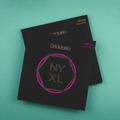Player Spotlight - Reverend Billy F. Gibbons
By Strings Direct – 29 August, 2023

The journey continues and we head back down to the Lone Star State where the barbecues smoke and the beers are chilled... a place where the blues is firmly rooted but ever evolving.
Houston, Texas. December 16th, 1949 was an iconic day for rock 'n' roll...the birth of Mr Rock 'n' Roll Riff, an unstoppable blues machine that takes no prisoners and asks no questions. An icon of tone with mesmerising presence, louder than life and bigger than love. A sharp dressed man! Oh boy you better understand!! 🎸 Take us to church Reverend Billy F. Gibbons.

“Well, growing up, we had a house keeper who listened to blues radio all day and all night. It didn’t seem to be anything out of the ordinary. It was always around - at least around the house. Then when I was five years old, my mom took myself and my little sister out to see Elvis Presley live. I said, ‘Man, that’s what I wanna do!’”
Billy Gibbons - Ed Mitchell (Guitarist) Musicradar.com
Texas Blues Boy
In this instalment we discover and truly appreciate one of rock 'n' rolls true Hall of Fame guitar machines.
Music and melody runs through Billy Gibbons to this day and this was present early on via a wealth of musical surroundings as a youngster.
As many do, The Rev absorbed inspiration from his father who worked as a concert pianist and orchestral conductor and often found work with MGM Studios, the mecca of entertainment at the time.
One of his earliest musical memories was of course witnessing Elvis live, but it was his next musical encounter that really formed Billy's vision of where he needed to be.
“My dad was an entertainer. When I was seven years old he said, ‘Listen, hop in the car. I wanna take you with me. I’ve got business to take care of at the recording studio.’ We went into the studio, he parked me in a chair and said, ‘You’ll probably like this, they’re recording a band. I’ll be in the office if you need me…’ It turned out to be a BB King recording session. So, between seeing Elvis Presley and BB King I thought, ‘Man, this is it. This is for me!”
Billy Gibbons - Ed Mitchell (Guitarist) Musicradar.com

So the first guitar … we all remember it 😉 . We have mixed feelings about these across-the-board. Some are very sentimental, some are just purely embarrassed and some are shocked at how their musical identity has evolved. We've all got a guitar buddy that started out as a full on hair metal thrash player and has mellowed into a classical guitar maestro and left his mysterious metal past behind 😎. It could even be you!
But, with Billy Gibbons his first guitar and amplifier was so cool it has to be covered here in a little more detail than normal.
In 1963 for his 13th birthday, Billy received what we would call then a little starter guitar package... a sunburst Gibson Melody Maker accompanied by a Fender Tweed champ amplifier.
By today's standards that very modest little set up is pretty much a vintage guitar enthusiasts dream.
Junior and student model guitars with a single pick up and single cut away coupled with small early Fender amplifiers are now the benchmark of what can be seen as perfect vintage tone.
Billy began plugging away on this perfect little set up and cites early influences such as Jimmy Reed, BB King, Albert King , Muddy Waters, Howlin’ Wolf to name but a few.
Whether the styles originated from Chicago, the Mississippi Delta, Texas, or Great Britain - Billy absorbed them all, and each has played an important role in forming what has become his own recognisable sound.
“The blues is a mighty long road. Or it could be a river, one that twists and turns and flows into a sea of limitless musical potential. The blues is life itself.”
Billy Gibbons - Joe Bosso - musicradar.com

Blues Brother To The Band(s)
Honing his craft, night and day, Billy formed several bands including The Saints, Billy G & the Blueflames, and The Coachmen whilst studying at Warner Brothers School of Art in Hollywood, California.
At the age of 18, things really started to progress and Gibbons formed a conceptual art design band with psychedelic rock pioneer Roky Erickson.
'The Moving Sidewalks' were born and completed one full album and various tours. Upon one of the tours, opportunity presented itself and the band found themselves supporting The Jimi Hendrix Experience.
An absolute honour and fascination at the time, Gibbons recalls Jimi offering some advice and guitar lessons on the intro to Foxy Lady.... this one fact is incredible rock 'n' roll history. 🎼

After a good run and some great success, the project finally came to an end in 1969 and members parted ways creatively onto new ventures.
Billy Gibbons looked to move into a more straightforward, straight talking project that would focus on boogie woogie blues and give a real kick towards the groove.
Moving back down to Texas, Billy eventually formed the group that would become the powerhouse trio we know as ZZ Top.
“Bassist Dusty Hill and drummer Frank Beard, ZZ Top were born. The power trio slowly but steadily built up a solid following, largely due to Gibbons' tasty guitar playing and muscular riffs (especially evidenced on such renowned tracks as "La Grange" and “Tush”)."
allmusic.com - Artist Biography by Greg Prato
To this day, this riff is so simple yet so effective it's it's up there with the best rivalling 'Satisfaction' and 'Smoke On The Water'. The guitar sounds are phenomenal and the trio are such a tight unit that the communication through pure feel and groove is something to truly behold.
This unspoken purity within the musicianship is what makes this band so exciting to watch and listen to.
ZZ Top of course went on to become Rock ’n’ Roll stars in every sense of the word...and rightfully so!
This powerhouse trio put blues back on the jukeboxes in the early 70's, going somewhat against the grain and stayed true to that shuffle that makes them who they are.
“Texas is where the blues always finds salvation in times of trouble. The Lone Star State was the birthplace of T-Bone Walker, the first blues superstar. He showed kids like BB King that Delta blues was dead. The future was a killer suit, a big-ass grin and an electric guitar.”
Billy Gibbons - Ed Mitchell (Guitarist) Musicradar.com
I honestly believe it doesn't matter what type of music you're into or what style you prefer, this is undeniable groove in every aspect... the playing is astonishing and this trio are so tight it almost doesn't sound live... but it truly is 🤘.
These guys make rock 'n' roll cool look effortless and Gibbon’s guitar playing is a joy to watch. This is timeless stuff... ZZ Top are rock 'n' roll gold. 😎
The Holy Grail Les Paul …
As previously mentioned, we have to talk about his iconic guitar and more so the story behind it.
No matter how many times you hear it, it's pure magic and is the stuff that rock 'n' roll legend is built on.
A 1959 Gibson Les Paul is the pinnacle of guitars... possibly the most desirable guitar in the world and one of the most expensive guitars to boot!
The myth and legend that surrounds these guitars is built on the history provided by the players of the golden era.
To this day Billy Gibbons still tells the story of his iconic 1959 Les Paul known affectionately and famously as the great ‘Pearly Gates”. It has shaped the history of Billy Gibbons and has been on pretty much every recording he's ever laid down to tape. It is as much an iconic piece of his arsenal as it is a spiritual icon in his musical journey.
Like many guitar players on the scene back then, it was the presence of a young Eric Clapton on John Mayall’s Blues Breakers album that sparked the interest and desire for these guitars.
“I got very lucky,” he says. “A friend said, ‘Hey, weren’t you looking for one of those Les Paul guitars like your buddy Clapton?’ I said, ‘Yeah. They’re so hard to find.’ “Anyway, he said there was one on a ranch just outside of Houston. An old cowboy has it. So, I jumped at the opportunity… and that was Pearly Gates."
“Where did the name come from? Well, we had a girl friend who had an opportunity to take a part in a movie, but she had no way to get to California. I said, ‘Well, we have an old car, a 1936 Packard. We’re gonna give you this car and you must go to California.’
“We called the car 'Pearly Gates'. She did get to California. She did get the part. She sold the car and sent me some money. The day the cheque arrived was the day I went to see the guitar. I said, ‘How much do you want for it? How about $250?’ That was exactly the amount that was written on the cheque. He said, ‘Okay. Go play!’”

Big Tone = Big Strings Right?!? …🤔
So here is where things get really interesting. When we think of ZZ Top we think of big powerful, stomping grooves fuelled by a deep, thick dynamic wide open full range electric guitar tone.

So Billy's gonna be using a big string to fill all that space and add all that energy right….?! Think again!
Whilst he was looking at things from that persepective up until the age of 22, it was a second encounter with the great B.B. King that altered Billy Gibbons persepective on string gauge.
String advice from the King 👑
“Early on I got the privilege of sharing a dressing room with BB King upon which he said, ‘Hey, do you mind if I have a few strums on your guitar?’ Well, at the time, I was thinking to get the big, bad, loud sounds from the blues guys. You had to have super heavy strings, and it just took one or two strums and BB looked at me kind of quizzically and he said, ‘Why are you working so hard?'”
“‘Well,’ I said, ‘What exactly does that mean?’ And he said, ‘Well, these strings are so heavy.’ I said, ‘Well, isn’t that what you need to get the big, bad sound?’ He said, ‘No, back in the day, when there was only one set of strings available, the Black Diamond, one gauge, we used to do a trick. We used to have to throw away the big E string, move everything down one, and then borrow a banjo string to make a light gauge set.'”
Billy Gibbons - http://rockandrollgarage.com/ Rafael Polcaro
So from this conversation onwards, Billy Gibbons has stuck to that incredible advice and seeked out the lightest strings possible.
Now string gauge is a topic that's heavily debated every single day in the world of guitar players.
Everyone has their opinion, but is there any right or wrong?
Does a larger string mean a larger sound? In fact, we covered this very topic in a blog post right here.
An everlasting topic I believe, but one that can be somewhat closed down when you listen to Reverend Billy Gibbons shred a riff.

Stop - Look - listen 🎶
The B.F.G is playing .07-.38.... you better believe it man ✌️
References
https://www.jimdunlop.com/billy-gibbons-custom-rev-willys-guitar-strings-07-38/
https://www.allmusic.com/artist/billy-gibbons-mn0000067539/biography
https://en.wikipedia.org/wiki/Billy_Gibbons
https://www.musicradar.com/news/guitars/billy-gibbonss-10-favourite-blues-albums-of-all-time-460219





